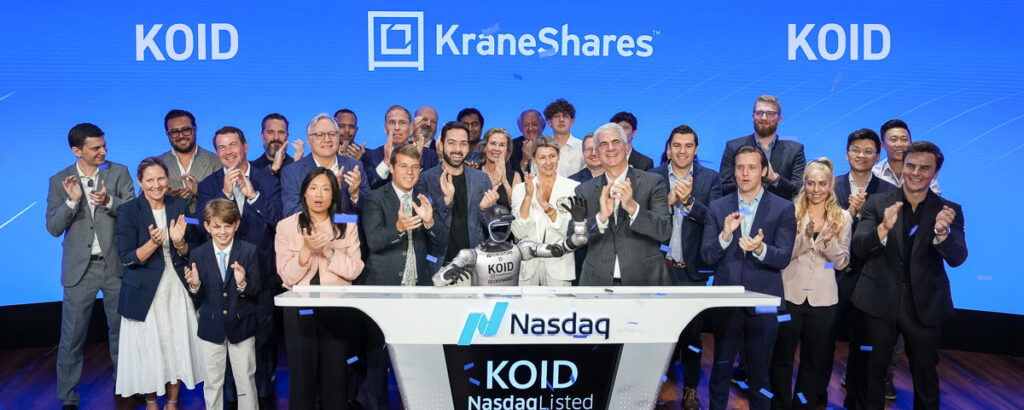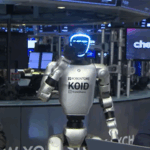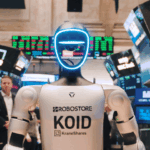
FAQ: How To Invest In Humanoid Robotics & Embodied Intelligence With KOID ETF
Is there a humanoid robotics ETF?
Yes, the KraneShares Global Humanoid and Embodied Intelligence Index ETF (Ticker KOID). What is a humanoid robotics ETF? A humanoid robotics ETF invests in companies developing or supplying technologies for humanoid robots, machines capable of interacting, reasoning, and working in human environments. These robots are being increasingly deployed across various sectors, including manufacturing, healthcare, logistics, and consumer sectors. Investing in a humanoid robotics ETF enables investors to participate in the performance of robotics stocks and next-gen automation without needing to pick individual winners.
What is the KOID ETF?
The KraneShares Humanoid Robotics & Embodied Intelligence Index ETF (Ticker: KOID) is the first humanoid robotics ETF listed on Nasdaq on June 5th, 2025. KOID is designed to capture the development of humanoid robots and embodied intelligence systems, a potential megatrend in the coming decades. The KOID ETF aims to provide investors with global exposure to companies developing or enabling humanoid robotics, embodied artificial intelligence (AI), and intelligent automation technologies shaping the future of robotics investment.

What are humanoid robots?
Humanoid robots are considered intelligent (based on the use of advanced AI algorithms), life-sized and human-like machines designed to perform tasks typically carried out by humans. Powered by advancements in AI, robotics, and neural networks, these robots can move, perceive, and communicate with people. With models like Tesla’s Optimus Gen3, the Unitree G1 Ultimate, and the Figure 03 emerging, humanoid robotics is accelerating the eventual transformation of everyday work and domestic life.
What is embodied intelligence?
Embodied intelligence refers to AI that exists within a physical body. Unlike software-only AI, embodied intelligence integrates perception, cognition, and movement, allowing machines to interact with the real world through sensory feedback. Embodied intelligence ETFs, like the KOID ETF, enable investors to gain exposure to companies leading innovation in robotic mobility, reinforcement learning from human feedback (RLHF), and AI-driven control systems.
Why invest in humanoid robotics and embodied intelligence?
Investing in humanoid robotics taps into the heart of global technology disruption. With robotics potentially becoming the backbone of next-generation industries and work automation, this thematic investment addresses major global challenges such as aging demographics and labor shortages. According to Morgan Stanley, the global humanoid robotics total addressable market could approach $5 trillion by 2050.1 The KOID ETF is a next-gen robotics fund that seeks to capture this opportunity through both current leaders and early-stage innovators.
How does the KOID ETF select its holdings?
The KOID ETF begins with a universe of over 3,000 global stocks, filtering to 800+ companies deeply engaged in humanoid robotics and embodied intelligence. Each company is assigned a proprietary exposure score based on corporate disclosures, partnerships, and technology focus. The KOID ETF then selects the top 50 companies with the strongest alignment between humanoid and embodied AI, using an equal-weight methodology that aims to offer balanced exposure across emerging innovators and established players.
Why is equal weighting important for this ETF?
Equal weighting allows the KOID ETF to avoid overexposure to mega-cap tech stocks that participate peripherally in robotics. Instead, it emphasizes companies directly driving innovation in humanoid and embodied intelligence, including component suppliers, sensor manufacturers, and AI developers. This structure helps capture value creation in smaller companies, as well as mega-cap tech stocks, early in the robotics growth cycle while maintaining a future-forward investment approach.
What types of companies and markets does KOID invest in?
The KOID ETF offers international exposure to the United States, China, Japan, Germany, and other key markets. We believe many of these companies in the KOID ETF remain underrepresented in standard investor portfolios, offering potentially differentiated exposure to the robotics and AI stocks.
How is embodied intelligence changing robotics in 2025?
In 2025, embodied intelligence is redefining how robots learn and adapt. With the help of large language models (LLMs) like GPT and Gemini Pro, humanoid robots can interpret natural language instructions and perform complex reasoning. Reinforcement Learning from Human Feedback (RLHF) allows robots to acquire new manipulation skills in just a few human demonstrations, reducing development cycles and enabling scalable deployment across industries.
What are the top trends in embodied intelligence investment?
The top trends in embodied intelligence investment for 2025 include the integration of frontier AI models into physical robotics, the democratization of low-cost humanoid hardware, and the expansion of use cases across healthcare, manufacturing, and home assistance. The growing adoption of humanoid and service robots is projected to fuel sizable demand for sensors, compute hardware, and AI training infrastructure, key sectors within the KOID ETF’s portfolio.
How is the humanoid robotics market evolving?
The humanoid robotics market is entering a phase of mainstream adoption. By 2030, analysts project that humanoid robots could replace up to 20 million production jobs globally and generate trillions of dollars in economic value.2 Medical and domestic humanoid robots are seeing rapid expansion, with healthcare applications expected to exceed $21 billion by 2028.3 The KOID ETF provides investors with a structured way to benefit from this advanced robotics theme as it scales.
What are the bottlenecks for humanoid robotics in 2025?
In 2025, key bottlenecks include raw materials, robot component manufacturing, and supply chain scalability. The KOID ETF addresses this by investing not just in the finished robot makers but also in foundational suppliers driving innovation in sensors, actuators, batteries, and lightweight materials, potentially allowing investors to benefit from every layer of the humanoid robotics ecosystem.
Does KOID invest in rare earth metal companies?
Yes, KOID invests in rare earth metal companies, including U.S.-based MP Materials Corp (3.02% weight in KOID), Australia’s Lynas Rare Earths LTD (3.06% weight in KOID), and China Northern Rare Earth (3.27% weight in KOID).4 We believe that rare earth companies are an important part of the humanoid robotics ecosystem, and according to Bloomberg data, they have been early beneficiaries of advances in robotics.4
What makes KOID a robotics ETF to watch?
KOID stands out as a robotics ETF to watch in 2025 because it directly targets the convergence of humanoid robotics and embodied AI, an inflection point we believe is similar to AI’s 2023 breakout moment with ChatGPT. Through equal weighting, global diversification, and proprietary exposure scoring, KOID aims to provide investors with exposure to companies involved in humanoid robotics and embodied intelligence.
For KOID standard performance, top 10 holdings, risks, and other fund information, please click here.
KOID is a non-diversified fund. The statement regarding diversification refers to sector and geographic exposure, not regulatory diversification under the Investment Company Act of 1940.
Citations:
- Data from "A $5 Trillion Global Market," Morgan Stanley, retrieved 9/30/2025.
- Data from Oxford Economics and the BBC, retrieved 9/30/2025.
- Data from Statista, retrieved 9/30/2025.
- Data from Bloomberg as of 9/30/2025.










